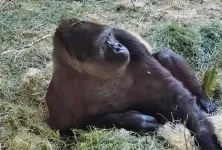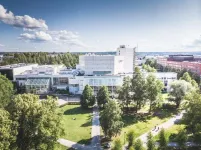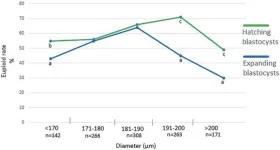(Press-News.org) The DNA of human cells consists of a sequence of about 3.1 billion building blocks. Cells go to great lengths to maintain the integrity of this vast store of information. They constantly untangle knots in the DNA strand and create new chemical bonds when a strand of DNA breaks somewhere in the nucleus.
“When people read about repairing genetic material, they often think of it being in response to exposure to toxins or radiation,” says Jacob Corn, Professor of Genome Biology at ETH Zurich. However, repair mechanisms not only defend against external threats; they also play a crucial role in helping cells survive the challenges they face in their daily fight for survival.
Wealth of new interactions
Scientists have long known that more than 500 genes (out of approximately 20,000 human protein-coding genes) are crucial for DNA repair. By comprehensively analysing the interactions of these genes, Corn and his team have gained important new insights into how cells maintain the integrity of their genome. The researchers have discovered a wealth of new interactions and have identified potential new targets for cancer therapy, as reported in the journal Nature.
The researchers modified human cells in culture to switch off two of the repair genes simultaneously. “We took a systematic approach and looked at all possible combinations,” says Corn. That’s easier said than done, because the researchers looked at nearly 150,000 different combinations of inactivations. “There was a lot to figure out,” say John Fielden and Sebastian Siegner, the two lead authors who carried out most of the study.
“Human cells love redundancy”
Inactivating a single gene is usually not enough to produce a noticeable effect because another gene often compensates for the missing function. “Human cells love redundancy,” says Corn. Only when the backup is also switched off do they lose the ability to repair the genetic material. Sooner or later, the damage accumulates to a point where survival is no longer possible.
This was the case for about 5,000 inactivated gene pairs. In their paper, the researchers provide a detailed description of the molecular interactions lost for two specific gene pairs. In their investigations, they uncovered previously unknown links that appear to be essential for the cell’s survival.
New clues for cancer therapy
The researchers’ work not only offers important insights but also provides new possibilities for cancer therapy. Cancer cells have more mutations than normal cells. For this reason, some of the 500+ repair genes are already switched off in some cancer cells. “Our research has identified the additional genes that need to be inactivated to prevent the growth of cancer cells,” says Fielden.
In the paper, the team lists a number of previously unknown links between common cancer mutations and molecular targets that can be blocked with drugs. “These newly discovered potential vulnerabilities in cancer cells now need to be tested. We have shown the pathways through the dark forest,” says Corn. “Now it’s easy to walk those paths.” He and his team have created a new web platform where their results are publicly available. “We hope that other researchers will benefit from this and actively use the platform,” adds Corn. This would help to ensure that new knowledge about genetic interactions bears fruit as quickly as possible.
END
How human cells repair damaged DNA
2025-04-09
ELSE PRESS RELEASES FROM THIS DATE:
Your skin is breathing. New wearable device can measure it.
2025-04-09
Northwestern University researchers have developed the first wearable device for measuring gases emitted from and absorbed by the skin.
By analyzing these gases, the device offers an entirely new way to assess skin health, including monitoring wounds, detecting skin infections, tracking hydration levels, quantifying exposure to harmful environmental chemicals and more.
The new technology comprises a collection of sensors that precisely measure changes in temperature, water vapor, carbon dioxide (CO2) and volatile organic compounds (VOCs), which each give valuable ...
Serendipitous discovery could lead to more efficient catalysts
2025-04-09
PULLMAN, Wash. – Preparing catalysts by sending hot, steamy car exhaust over them could improve their efficiency and reduce the amount of rare and expensive metals required in vehicle catalytic converters and many other emission control and industrial processes.
Reporting in the journal, Nature, an international team of researchers found that the hot car exhaust containing nitrogen oxides and carbon monoxide caused a previously unknown reaction that, used proactively, can significantly improve catalytic activity. Catalysts are substances that increase the rate of chemical reactions.
The researchers found that hot exhaust encouraged ceria particles, one of the components of the ...
Engineering smart delivery for gene editors
2025-04-09
Overcoming Delivery Challenges in Gene Editing
Modern genome editing techniques, including CRISPR systems, hold great potential for treating genetic diseases. However, delivering these molecular tools reliably to their target cells remains a significant challenge.
“Previous viral and non-viral delivery systems such as adeno-associated viruses (AAVs), lipid nanoparticles (LNPs), and other virus-like particles (VLPs), have been valuable but face limitations,” says Dr. Dong-Jiunn Jeffery Truong, last author ...
Six ape genomes sequenced telomere-to-telomere
2025-04-09
Comprehensive reference genomes have now been assembled for six ape species: siamang (a Southeast Asian gibbon), Sumatran orangutan, Bornean orangutan, gorilla, bonobo and chimpanzee. Areas of their genomes previously inaccessible because of structural complexity have now mostly been resolved.
The resource is already lending itself to comparative studies that offer new insights into human and ape evolution, and into what underlies the functional differences among these species.
A report on how the telomere-to-telomere ape genome references were developed, and what scientists are learning from it, appears in the April 9 edition ...
Hubble Space telescope unveils the first images of ongoing star cluster mergers near the center of dwarf galaxies
2025-04-09
A new study reports the first direct observation of merging star clusters in the nuclear region of dwarf galaxies. This detection confirms the feasibility of this formation route for nuclei in dwarf galaxies, which has long been debated. The study was published in Nature science journal, and led by Postdoctoral Researcher Mélina Poulain from the University of Oulu, Finland.
Dwarf galaxies are the most abundant type of galaxies that populate the Universe. Composed of 100 times fewer stars than the ...
‘Sugar’ signatures help identify and classify pancreatic cancer cell subtypes
2025-04-09
GRAND RAPIDS, Mich. (April 9, 2025) — Van Andel Institute scientists and collaborators have developed a new method for identifying and classifying pancreatic cancer cell subtypes based on sugars found on the outside of cancer cells.
These sugars, called glycans, help cells recognize and communicate with each other. They also act as a cellular “signature,” with each subtype of pancreatic cancer cell possessing a different composition of glycans.
The new method, multiplexed glycan immunofluorescence, combines ...
Every cloud has a silver lining: DeepSeek’s light through acute respiratory distress syndrome shadows
2025-04-09
Acute respiratory distress syndrome (ARDS) continues to be a tough nut to crack in critical care, taking lives despite years of research and better ventilator strategies. It is defined by acute hypoxemia, bilateral infiltrates on chest imaging, and non-cardiogenic pulmonary edema, and it remains a heterogeneous condition with mortality rates stubbornly close to 40%. Its complexity—spanning diverse etiologies, inflammatory profiles, and therapeutic responses—demands innovative solutions beyond traditional paradigms. In recent years, artificial intelligence ...
Scientific Program announced for inaugural eLTER Science Conference in Finland
2025-04-09
The scientific programme for the inaugural eLTER Science Conference has just been launched, marking a major milestone in the lead-up to the event. Held from 23 to 27 June 2025 in Tampere, Finland, the conference will explore integrated, policy-relevant approaches to ecosystem and socio-ecological research under the theme: “Toward a whole-system approach to ecosystem science.”
Organised by the Integrated European Long-Term Ecosystem, critical zone and socio-ecological systems Research Infrastructure (eLTER RI), the event is expected to welcome over 300 participants from across Europe and beyond.
The scientific programme features:
25 keynote speakers recognised for their leadership ...
Does blastocyst size matter? Exploring reproductive aging and genetic testing
2025-04-09
“[…] when selecting non-PGT-A tested embryos for embryo transfer (ET) or frozen embryo transfer (FET), a small hatching blastocyst seems to be a better choice than a large expanded one, especially for advanced-age patients for whom the risk of aneuploidy is higher.”
BUFFALO, NY — April 9, 2025 — A new research paper was published in Aging (Aging-US) Volume 17, Issue 3, on March 5, 2025, titled “Reproductive aging, preimplantation genetic testing for aneuploidy, and the diameter of blastocysts: does size matter?”
In this study, a team led by first author Jakub Wyroba from the Malopolski Institute of Fertility Diagnostics ...
2025 EurekAlert! Travel Awards for International Science Reporters applications now open
2025-04-09
Applications for the 2025 EurekAlert! Travel Awards for International Science Reporters are now open to early-career science journalists from Brazil and countries in Eastern Europe. Two winners will be selected to receive travel funding from EurekAlert! to attend the 2026 AAAS Annual Meeting, taking place February 12-14, 2026 in Phoenix, Arizona, USA. Learn more about who is eligible and how to apply on our website. The application deadline is May 5 at 11:59 p.m. U.S. Eastern Time.
Learn More and Apply!
The American Association for the Advancement of Science (AAAS) is the world’s largest multidisciplinary scientific society, and the AAAS Annual Meeting brings together ...




